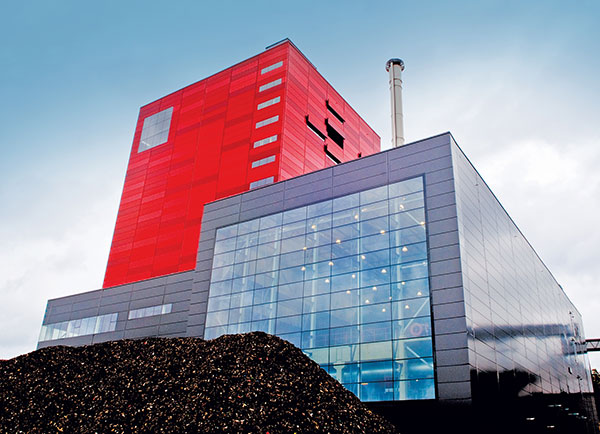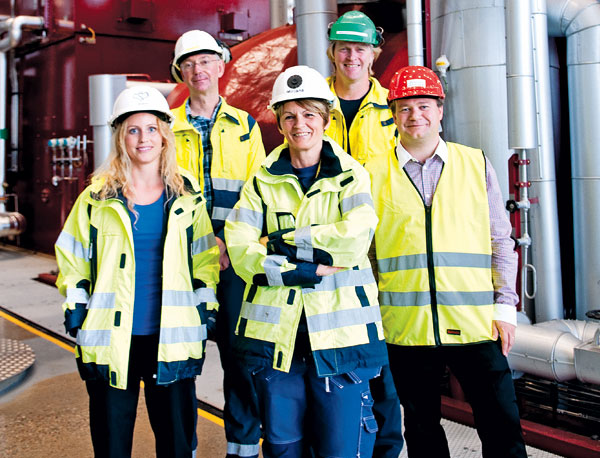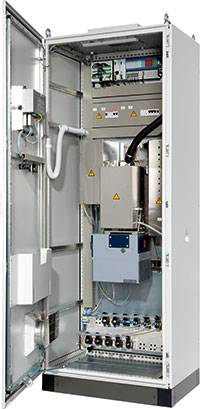Not only is the Igelsta plant one of Swedens largest biomass power plants; situated in a very scenic location near the entrance to the Baltic Sea, the plant received recognition as the Building of the Year in 2009. It produces green energy for 100,000 homes and district heating for 50,000 homes - measurement technology from SICK monitors the emission.

 Scattered light dust measuring device DUSTHUNTER FWE200
Scattered light dust measuring device DUSTHUNTER FWE200
When the sun vanishes behind the clouds, we see energy demand shoot up, says Peter Hillblom, a mechanical engineer at the Igelsta plant in Södertälje. We use measuring technology from SICK — the MCS100FT CEMS solution and also the DUSTHUNTER FWE200 scattered light dust measuring device for wet gases — to monitor our emissions, ensuring that they always fall within legal limits. Our aim is to keep improving. In order to meet power and heat generation requirements, the power plant requires approx. 17,000 tonnes of fuel every week. The fuels used are mainly derived from forestry waste, such as chopped up wood from trees, supplemented by fuels derived from non-recyclable waste from the local area, such as waste wood, plastic, and paper.

High-energy fuels for the "St. Martin's Goose" turbine
The steam produced through this combustion process is used to heat water for district heating and also to power the "St Martin's Goose" steam turbine. The turbine was commissioned on St Martins Day in 2009 and takes its name from the meal traditionally eaten at this time of feasting. Nevertheless, the powerful red turbine looks more like an organic monster than a high-tech creation. In the middle of the plant, the turbine is driven by high-pressure steam at a temperature of 540 ºC. This in turn powers an enormous generator which supplies 11 kV and 85 MW of power — enough to light up over 1.4 million 60 W-light bulbs.
 Kristina Arveng, Peter Hillblom, Mirjana Mijatovic und Niclas Thorell from Igelsta. Torbjörn Melin (right), service manager from SICK
Kristina Arveng, Peter Hillblom, Mirjana Mijatovic und Niclas Thorell from Igelsta. Torbjörn Melin (right), service manager from SICK
Söderenergi — a pioneer in the use of secondary fuels
Coal was the fuel used in the first Igelsta plant back in 1982. Social changes and the introduction of a CO2 tax brought about a change: We were very quick to start cutting down on fossil fuels and were soon able to switch to biomass and recycled raw materials. Our CO2 emissions fell by 80 %, explained Madeleine Engfeldt-Julin, Communications Manager at Söderenergi. We can consider ourselves successful pioneers in the use of secondary fuels. Our highly developed gas cleaning system means that the emissions coming out of our chimneys are almost exclusively steam, she added. Not only is the number of pollutants very low now; Söderenergi is also constantly develop ing and refining its use of biological and recycled fuels.
The first company in Sweden to use SICK's FTIR measuring technology
In 2009 Söderenergi became the first company in Sweden to measure emissions using the new MCS100FT CEMS solution, which is based on FTIR technology (Fourier transform infrared spectroscopy.) The system measures HF, HCI, NH3, H2O, CH4, SO2, N2O, CO, NO, NO2, CO2 and O2. As an option, it can also determine both NOx and VOC/THC concentrations. Research proves that the gas analysis systems deliver results with a consistently high measurement accuracy for up to 14 components measured used together in the same system. The DUSTHUNTER FWE200 scattered light dust measuring device from SICK uses an extractive dust measuring system to determine particle emissions at temperatures below 100°C (below the acid dew point of the exhaust emissions.) The SICK measuring systems are part of a monitoring and IT network which allows various measurement points within the plant to be remote controlled. This has one distinct advantage for Peter Hillblom: "I can access the same images as the IT staff in the control room without having to go there myself."
- Product information: MCS100FT CEMS solution, DUSTHUNTER FWE200 scattered light dust measuring device
- Product portfolio: Dust measuring devices, analyzer systems
- Customer information: Söderenergi


